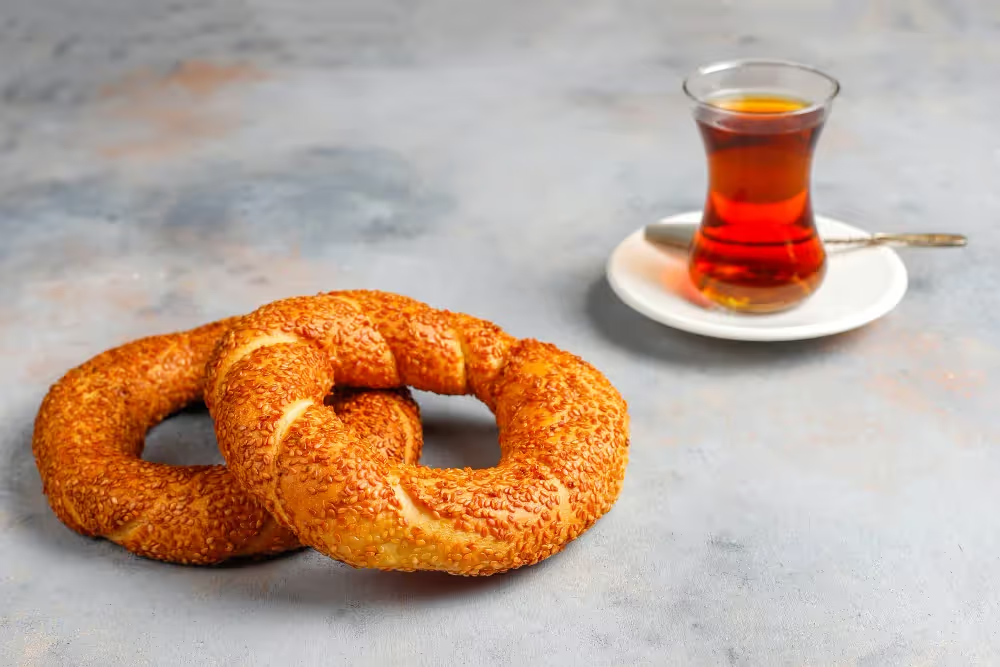
Menu

Book a table

Have you ever walked through the streets of Istanbul and noticed golden rings of bread stacked high on carts?
That is simit, Turkish bread, one of the country’s most beloved street foods. Known for its crunchy crust and sesame seed coating, simit is not just bread; it is a cultural symbol that has nourished generations. From breakfast tables to afternoon tea, simit remains an essential part of daily Turkish life.
Simit, often referred to as Turkish simit bread, is a circular bread coated with sesame seeds and baked until crisp on the outside and soft inside. Its texture is lighter than a bagel but chewier than a baguette, making it unique. The bread is usually about the size of a hand and sold fresh by street vendors, bakeries, and cafés across the country.
While it may look simple, simit holds a special place in Turkish food culture. It is often eaten plain, with tea, or paired with cheese, olives, and jam for breakfast. For many, simit bread is both comfort food and a symbol of Turkish hospitality. This is a must-try if you need a family-friend Turkish food experience.
The origins of simit, Turkish bread, go back several centuries. Historical records suggest it was first made during the Ottoman Empire, with the earliest references appearing in the 16th century. In those times, bakers developed simit as an affordable and filling food for the working class. Its circular shape and sesame crust became instantly recognizable, and it quickly spread across the empire.
By the 19th century, simit had become a common sight on the streets of Istanbul, sold from large trays balanced on vendors’ heads. This tradition continues today, with simit carts, known as “simitçi,” dotting every corner of Turkey’s cities and towns.
The process of making Turkish simit is simple yet precise. The dough is prepared using flour, water, yeast, and a pinch of sugar and salt. Once risen, it is rolled into long ropes, twisted, and shaped into rings. The unique step comes before baking: the rings are dipped into a mixture of water and grape molasses, then coated generously with sesame seeds.
The molasses not only helps the sesame seeds stick but also gives simit bread its deep golden-brown color and subtle sweetness. Once baked, the result is a crunchy, fragrant bread with a nutty flavor.
Simit is often called “the people’s bread” because it is affordable and widely available. Street vendors sell it early in the morning to workers and students on their way to school or the office. Many Turks pair simit, Turkish bread, with a glass of hot black tea, creating a quick and satisfying breakfast.
At home, simit is commonly served with cheese, olives, cucumbers, tomatoes, and jam as part of a traditional Turkish breakfast spread. It is also enjoyed as a snack throughout the day, often carried to parks, picnics, or shared with friends. For many families, simit is a taste of comfort that connects generations.
To outsiders, a simit may look like a bagel, but they are not the same. Bagels are boiled before baking, giving them a dense and chewy texture. Turkish simit bread, on the other hand, is dipped in molasses water and baked directly, which makes it lighter, crispier, and more fragrant. The sesame seed coating also sets it apart, adding a distinctive crunch.
This comparison highlights how simit stands on its own as a unique Turkish dish rather than a simple variation of other breads.
Though simit is popular across Turkey, its appearance and taste can vary by region. In Istanbul, simit is thin and crunchy, while in Ankara, it is thicker and softer. Izmir simit, sometimes called “gevrek,” is known for its extra-crispy texture. These small differences show how one beloved bread can adapt to local preferences while maintaining its essential character.
Beyond Turkey, variations of simit, Turkish bread, can be found in neighboring countries such as Greece, Lebanon, and the Balkans, where it is also enjoyed as a street food. In addition, it makes a good item for Turkish breakfast in Dubai.
More than just food, simit represents community and tradition. Sharing simit with tea is a gesture of friendship. It is often present at family breakfasts, workplace breaks, and student gatherings. In Turkish literature and films, simit frequently appears as a symbol of simplicity and resilience.
Even during challenging economic times, simit remained accessible to everyone, earning it the nickname “the bread of the people.” Its endurance through centuries reflects its deep connection to Turkish identity.
Though simit has centuries of tradition, it continues to evolve in today’s culinary scene. From trendy cafés in Istanbul to bakeries abroad, simit, Turkish bread, is being reimagined in ways that keep it both timeless and modern.
In Turkey’s big cities, simit has moved from simple street carts into chic cafés and restaurants. Many establishments now serve simit with gourmet twists, paired with avocado, smoked salmon, or artisanal cheeses.
Brunch menus often feature simit alongside fresh juices and modern salads, appealing to a younger generation while keeping the essence of tradition alive. These innovations show how Turkish simit can adapt to new food trends without losing its identity.
The love for simit Turkish bread has crossed borders, appearing in bakeries and food stalls in Europe, the Middle East, and even North America. Turkish communities abroad introduced it to new audiences, who often compare it to bagels or pretzels but quickly realize its uniqueness.
In cities like London, Berlin, and New York, simit is now sold as part of multicultural street food markets, allowing people from all walks of life to experience this iconic bread.
Chefs are increasingly experimenting with simit as a base for creative dishes. Some restaurants use simit rings as sandwich bread, filling them with meats, cheeses, or vegetarian spreads. Others crumble simit to use as a crunchy topping for salads and soups.
Sweet versions are also emerging, with simit dipped in chocolate or stuffed with cream for dessert menus. These playful adaptations prove that Turkish simit bread is versatile and inspiring in global kitchens.
For tourists visiting Turkey, tasting simit is almost a rite of passage. Vendors near landmarks like Hagia Sophia or along the Bosphorus sell freshly baked simit to locals and visitors alike.

Tour guides often highlight simit as a symbol of everyday Turkish life, encouraging travelers to experience it with tea for an authentic moment. Many hotels also serve simit in breakfast buffets, introducing international guests to this cultural staple.
Beyond food, simit has become a cultural ambassador. Cookbooks, travel shows, and food documentaries often feature simit when introducing Turkish cuisine. Its simplicity and accessibility make it an easy entry point for foreigners to connect with Turkey’s food heritage.
The international recognition of simit Turkish bread reflects how a humble street food can carry the weight of history and identity across borders.
If you visit Turkey today, you will see simit, Turkish bread, sold everywhere, from small corner bakeries to high-end cafés. Street carts with bright red paint and glass windows filled with golden simit are especially iconic. Many locals and tourists alike grab one fresh from the cart, still warm, to enjoy on the go.
At home, simit can be reheated in the oven or paired with spreads like Nutella, honey, or tahini for a modern twist. Some restaurants even use it as a base for sandwiches, filled with cheese, vegetables, or cold cuts.
With its sesame-crusted crunch and soft interior, simit Turkish bread is more than a simple snack; it is a symbol of Turkish tradition, hospitality, and everyday life. From street carts in Istanbul to modern cafés worldwide, Turkish simit continues to unite people with its timeless flavor. Whether paired with tea, enjoyed at breakfast, or savored on the go, it remains one of the most iconic foods of Turkey.
To enjoy authentic simit Turkish bread and other traditional delights, visit Turkish Village. For reservations, call +971 (04) 3449955 or email reservations@turkishvillagedubai.com.
Yes, simit can be considered relatively healthy when eaten in moderation. It is made from simple ingredients such as flour, yeast, and sesame seeds. However, like any bread, it contains carbohydrates, so balancing it with vegetables, cheese, or protein makes it part of a nutritious meal.
Absolutely. Homemade Turkish simit bread requires basic ingredients: flour, yeast, sugar, salt, grape molasses, and sesame seeds. While the process is straightforward, getting the perfect crispness can take practice. Using molasses is essential for achieving the authentic color and flavor.
Traditionally, simit is eaten with tea for breakfast or as a snack. It pairs wonderfully with white cheese, olives, tomatoes, cucumbers, and jams. Some modern variations include filling simit with sandwich ingredients or serving it with chocolate spreads for children.
Simit varies by city: Istanbul’s version is thinner and crunchier, Ankara’s is softer, and Izmir’s “gevrek” is extra crispy. These variations reflect local tastes while still keeping the essential characteristics of simit bread. Travelers often enjoy tasting the differences as they move through regions.
Simit is deeply tied to Turkish identity because it has always been accessible and affordable. It represents community, simplicity, and daily tradition. Sharing simit with tea is a gesture of friendship, and its presence in both humble homes and city streets shows its cultural significance.